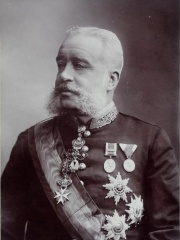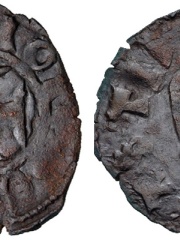POLITICIAN
Agapenor

 Agapenor
Agapenor
In Greek mythology, Agapenor (Ancient Greek: Ἀγαπήνωρ) was a leader of the Arcadians in the Trojan War. Read more on Wikipedia
His biography is available in 28 different languages on Wikipedia (up from 27 in 2024). Agapenor is the 10,917th most popular politician (down from 8,347th in 2024), the 549th most popular biography from Greece (down from 439th in 2019) and the 232nd most popular Greek Politician.
Memorability Metrics
Page views of Agapenor by language
Among POLITICIANS
Among politicians, Agapenor ranks 10,917 out of 19,576. Before him are Agenor Maria Gołuchowski, Lucius Cassius Longinus, Agesipolis I, Nils Jönsson, Yi San-hae, and Pasquale Cicogna. After him are Rafael Paasio, Saleh al-Arouri, Manuel Blanco Encalada, Matvei Platov, Christiaan de Wet, and Pierre Samuel du Pont de Nemours.
Most Popular Politicians in Wikipedia
Go to all RankingsAgenor Maria Gołuchowski
1849 - 1921
HPI: 60.38
Rank: 10,917
Lucius Cassius Longinus
151 BC - 107 BC
HPI: 60.38
Rank: 10,918
Agesipolis I
410 BC - 380 BC
HPI: 60.37
Rank: 10,919
Nils Jönsson
1390 - 1450
HPI: 60.37
Rank: 10,920
Yi San-hae
1539 - 1609
HPI: 60.37
Rank: 10,921
Pasquale Cicogna
1509 - 1595
HPI: 60.37
Rank: 10,922
Agapenor
HPI: 60.37
Rank: 10,923
Rafael Paasio
1903 - 1980
HPI: 60.37
Rank: 10,924
Saleh al-Arouri
1966 - 2024
HPI: 60.37
Rank: 10,925
Manuel Blanco Encalada
1790 - 1876
HPI: 60.37
Rank: 10,926
Matvei Platov
1753 - 1818
HPI: 60.37
Rank: 10,927
Christiaan de Wet
1854 - 1922
HPI: 60.37
Rank: 10,928
Pierre Samuel du Pont de Nemours
1739 - 1817
HPI: 60.37
Rank: 10,929
In Greece
Among people born in Greece, Agapenor ranks 549 out of 1,024. Before him are Peisander (-500), Philitas of Cos (-400), Crates (-350), Gregory VII of Constantinople (1850), Agesipolis I (-410), and Wehib Pasha (1877). After him are Spyros Markezinis (1909), Nikos Skalkottas (1904), Yorgos Lanthimos (1973), Ioannis Frangoudis (1863), Athanasios Diakos (1788), and Dimitrios Loundras (1885).
Others born in Greece
Go to all RankingsPeisander
MILITARY PERSONNEL
500 BC - 394 BC
HPI: 60.51
Rank: 543
Philitas of Cos
WRITER
400 BC - 360 BC
HPI: 60.47
Rank: 544
Crates
WRITER
350 BC - Present
HPI: 60.40
Rank: 545
Gregory VII of Constantinople
RELIGIOUS FIGURE
1850 - 1924
HPI: 60.38
Rank: 546
Agesipolis I
POLITICIAN
410 BC - 380 BC
HPI: 60.37
Rank: 547
Wehib Pasha
MILITARY PERSONNEL
1877 - 1940
HPI: 60.37
Rank: 548
Agapenor
POLITICIAN
HPI: 60.37
Rank: 549
Spyros Markezinis
POLITICIAN
1909 - 2000
HPI: 60.31
Rank: 550
Nikos Skalkottas
COMPOSER
1904 - 1949
HPI: 60.24
Rank: 551
Yorgos Lanthimos
FILM DIRECTOR
1973 - Present
HPI: 60.22
Rank: 552
Ioannis Frangoudis
MILITARY PERSONNEL
1863 - 1916
HPI: 60.17
Rank: 553
Athanasios Diakos
MILITARY PERSONNEL
1788 - 1821
HPI: 60.16
Rank: 554
Dimitrios Loundras
MILITARY PERSONNEL
1885 - 1971
HPI: 60.14
Rank: 555
Among POLITICIANS In Greece
Among politicians born in Greece, Agapenor ranks 232. Before him are Georgios Tsolakoglou (1886), Teucer (null), John II Orsini (1300), Alexandros Nikolopoulos (1875), Timotheus (-400), and Agesipolis I (-410). After him are Spyros Markezinis (1909), Jason of Pherae (-500), Eurycratides (-600), Echestratus (null), Argaeus II of Macedon (-500), and Archidamus I (-600).
Georgios Tsolakoglou
1886 - 1948
HPI: 60.72
Rank: 226
Teucer
HPI: 60.67
Rank: 227
John II Orsini
1300 - 1335
HPI: 60.57
Rank: 228
Alexandros Nikolopoulos
1875 - 2000
HPI: 60.56
Rank: 229
Timotheus
400 BC - 354 BC
HPI: 60.53
Rank: 230
Agesipolis I
410 BC - 380 BC
HPI: 60.37
Rank: 231
Agapenor
HPI: 60.37
Rank: 232
Spyros Markezinis
1909 - 2000
HPI: 60.31
Rank: 233
Jason of Pherae
500 BC - 370 BC
HPI: 60.14
Rank: 234
Eurycratides
600 BC - 590 BC
HPI: 60.11
Rank: 235
Echestratus
HPI: 60.08
Rank: 236
Argaeus II of Macedon
500 BC - 400 BC
HPI: 60.06
Rank: 237
Archidamus I
600 BC - Present
HPI: 60.01
Rank: 238

































